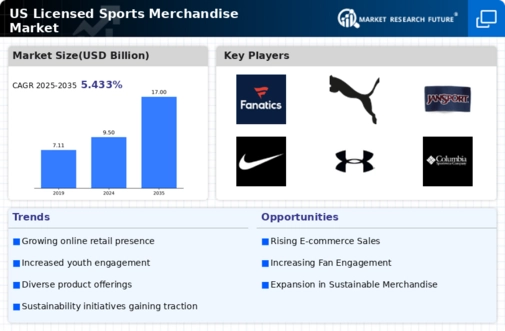Emergence of Customization Trends
Customization trends are reshaping consumer expectations within the licensed sports-merchandise market. Fans are increasingly seeking personalized merchandise that reflects their individual preferences and identities. This trend is evident in the growing popularity of customizable jerseys, hats, and other apparel, allowing consumers to add their names or unique designs. In 2025, it is anticipated that customized products could account for approximately 10% of total merchandise sales, as brands respond to this demand by offering more options for personalization. The ability to create unique items enhances the emotional connection fans have with their teams, thereby driving sales in the licensed sports-merchandise market.
Rising Popularity of Sports Events
The increasing viewership and attendance at sports events in the US has a profound impact on the licensed sports-merchandise market. Major leagues such as the NFL, NBA, and MLB have reported substantial growth in fan engagement, with attendance figures reaching millions annually. This heightened interest translates into a greater demand for licensed merchandise, as fans seek to express their loyalty and support for their favorite teams. In 2025, the licensed sports-merchandise market is projected to reach approximately $30 billion, driven by the enthusiasm surrounding live sports events. The emotional connection fans have with their teams fosters a culture of merchandise purchasing, which is likely to continue as sports events remain a staple of American culture.
Increased Focus on Youth Engagement
The licensed sports-merchandise market is witnessing a strategic shift towards engaging younger audiences. Sports organizations and brands are increasingly targeting youth demographics through tailored merchandise offerings and marketing campaigns. This focus on youth engagement is crucial, as studies indicate that individuals who develop brand loyalty at a young age are more likely to continue purchasing licensed merchandise throughout their lives. In 2025, the youth segment is projected to represent a significant portion of the market, with sales driven by trendy and innovative products. By fostering a connection with younger fans, the licensed sports-merchandise market is likely to secure its future growth and sustainability.
Influence of Celebrity Endorsements
Celebrity endorsements play a crucial role in shaping consumer preferences within the licensed sports-merchandise market. High-profile athletes and sports personalities often collaborate with brands to promote merchandise, significantly impacting sales. In 2025, it is estimated that endorsements could account for up to 15% of total merchandise sales, as fans are drawn to products associated with their favorite athletes. This trend is particularly evident in the apparel segment, where collaborations with well-known figures can lead to limited-edition releases that generate buzz and drive demand. The licensed sports-merchandise market benefits from this dynamic, as the association with celebrities enhances brand visibility and consumer interest.
Expansion of Online Retail Platforms
The proliferation of online retail platforms has transformed the way consumers access licensed sports merchandise. E-commerce sales in the licensed sports-merchandise market have surged, with estimates indicating that online sales account for over 40% of total merchandise sales in 2025. This shift towards digital shopping is facilitated by the convenience and accessibility of online platforms, allowing fans to purchase merchandise from the comfort of their homes. Additionally, the rise of mobile shopping applications has further streamlined the purchasing process, making it easier for consumers to find and buy their desired items. As a result, the licensed sports-merchandise market is likely to experience continued growth, driven by the expansion of online retail channels.






















Leave a Comment